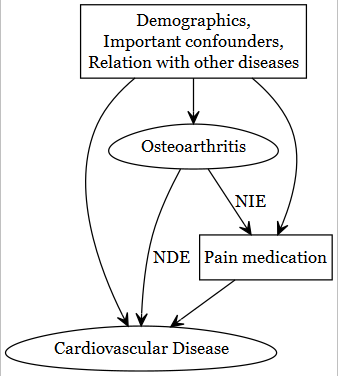Justification
We must show enough justification to do a mediation analysis. A causal diagram would be the first step to conceptualize the mediation analysis problem hypothetically. Then, we can empirically verify where doing the mediation analysis makes sense in that particular context.
Pre-processing
Load saved data
Prepared the data
Notation
- Outcome (\(Y\)): Cardiovascular disease (CVD)
- Exposure (\(A\)): Osteoarthritis (OA)
- Mediator (\(M\)): Pain medication
- Adjustment covariates (\(C\))
Hypothesis
- For total effect (TE): Is OA (\(A\)) associated with CVD (\(Y\))?

- For mediation analysis: Does pain-medication (\(M\)) play a mediating role in the causal pathway between OA (\(A\)) and CVD (\(Y\))? Here, we will decompose total effect (TE) to a natural direct effect (NDE) and a natural indirect effect (NIE).

Adjustment variables (\(C\)):
- Demographics
- age
- sex
- income
- race
- education status
- Important confounders
- BMI
- physical activity
- smoking status
- fruit and vegetable consumption
- Relation with other diseases
- hypertension
- COPD
- diabetes
Analysis/empirical exploration
Total effect
Outcome model (weighted) is
\(logit [P(Y_{a}=1 | C = c] = \theta_0 + \theta_1 a + \theta_3 c\)
Setting Design
require(survey)
summary(analytic.miss$weight)
#> Min. 1st Qu. Median Mean 3rd Qu. Max.
#> 0.39 21.76 42.21 66.70 81.07 2384.98
# Survey design
w.design0 <- svydesign(id=~1, weights=~weight, data=analytic.miss)
summary(weights(w.design0))
#> Min. 1st Qu. Median Mean 3rd Qu. Max.
#> 0.39 21.76 42.21 66.70 81.07 2384.98
sd(weights(w.design0))
#> [1] 80.34263
# Subset the design
w.design <- subset(w.design0, miss == 0)
summary(weights(w.design))
#> Min. 1st Qu. Median Mean 3rd Qu. Max.
#> 2.053 28.480 53.218 82.472 102.860 1295.970
sd(weights(w.design))
#> [1] 91.98946# Model
TE <- svyglm(outcome ~ exposure + age + sex + income + race + bmi + edu + phyact +
smoke + fruit + diab, design = w.design, family = quasibinomial("logit"))
# painmed is mediator; not included here.
TE.save <- exp(c(summary(TE)$coef["exposure",1],
confint(TE)["exposure",]))
TE.save
#> 2.5 % 97.5 %
#> 1.537005 1.230735 1.919489Exposure to OA has a detrimental effect on CVD risk (significant!).
Effect on the mediators
fit.m = svyglm(mediator ~ exposure + age + sex + income + race + bmi + edu +
phyact + smoke + fruit + diab, design = w.design,
family = binomial("logit"))
#> Warning in eval(family$initialize): non-integer #successes in a binomial glm!
med.save <- exp(c(summary(fit.m)$coef["exposure",1], confint(fit.m)["exposure",]))
med.save
#> 2.5 % 97.5 %
#> 2.428463 2.059265 2.863853Exposure to OA has a substantial effect on the mediator (Pain medication) as well (significant!). Hence, it would be interesting to explore a mediation analysis to assess the mediating role.
Save data
Video content (optional)
For those who prefer a video walkthrough, feel free to watch the video below, which offers a description of an earlier version of the above content.